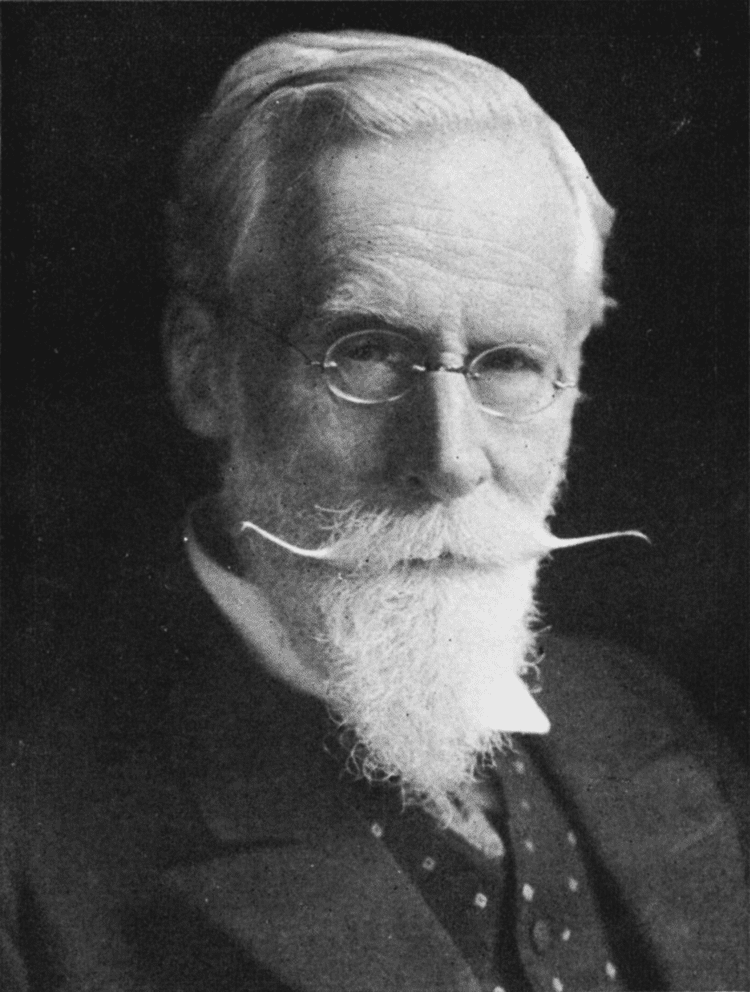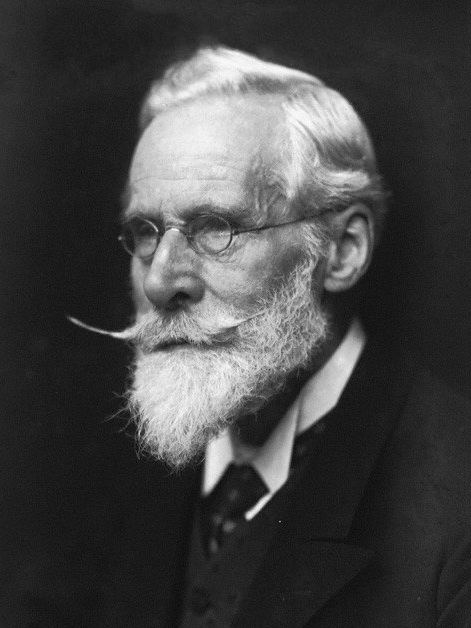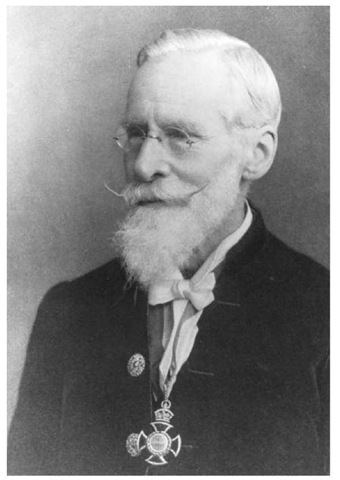Influenced J. K. F. Zollner Nationality English Name William Crookes | Role Chemist Known for Thallium | |
 | ||
Born 17 June 1832London, England, UK ( 1832-06-17 ) Notable awards Royal Medal (1875)Davy Medal (1888)Albert Medal (1899)Copley Medal (1904)Elliott Cresson Medal (1912) Parents Mary Scott Lewis Rutherford Johnson, Joseph Crookes Awards Copley Medal, Elliott Cresson Medal Books Researches in the Phenome, The Wheat Problem: Based on, Researches Into the Phenome, Diamonds, A Practical Handbook of Dyeing Similar People J J Thomson, Wilhelm Rontgen, Eugen Goldstein, Johann Wilhelm Hittorf, John Dalton | ||
William Crookes
Sir William Crookes (; 17 June 1832 – 4 April 1919) was an English chemist and physicist who attended the Royal College of Chemistry in London, and worked on spectroscopy. He was a pioneer of vacuum tubes, inventing the Crookes tube which was made in 1875. Crookes was the inventor of the Crookes radiometer, which today is made and sold as a novelty item. Late in life, he became interested in spiritualism, and became the president of the Society for Psychical Research.
Contents
- William Crookes
- William crookes video biography project
- Biography
- Early years
- Middle years
- Later years
- Spiritualism
- References

William crookes video biography project
Biography

Crookes made a career of being a meteorologist and fierce lecturer for multiple studies and courses. Crookes worked in chemistry and physics. His experiments were notable for the originality of their design. He executed them skillfully. His interests, ranging over pure and applied science, economic and practical problems, and psychiatric research, made him a well-known personality. He received many public and academic honors. Crookes's life was one of unbroken scientific activity.
Early years

William Crookes (later Sir William Crookes) was born in London, the eldest of 16 siblings. His father, Joseph Crookes, was a tailor of north-country origin, at that time living with his second wife, Mary Scott Lewis Rutherford Johnson.

From 1850 to 1854 he filled the position of assistant in the college, and soon embarked upon original work. It wasn't in organic chemistry which the focus of his teacher, August Wilhelm von Hofmann, might have been expected to lead him towards, but into new compounds of selenium. These were the subject of his first published papers, 1851. He worked with Manuel Johnson at the Radcliffe Observatory in Oxford in 1854, where he adapted the recent innovation of wax paper photography to machines built by Francis Ronalds to continuously record meteorological parameters. In 1855 he was appointed lecturer in chemistry at the Chester Diocesan Training College.
In 1856 he married Ellen, daughter of William Humphrey of Darlington. They had three sons and a daughter. Married and living in London, he was devoted mainly to independent work. In 1859, he founded the Chemical News, a science magazine which he edited for many years and conducted on much less formal lines than was usual for the journals of scientific societies.
Middle years
In 1861, Crookes discovered a previously unknown element with a bright green emission line in its spectrum and named the element thallium, from the Greek thallos, a green shoot. Crookes wrote a standard treatise on Select Methods in Chemical Analysis in 1871. Crookes was effective in experimentation. The method of spectral analysis, introduced by Bunsen and Kirchhoff, was received by Crookes with great enthusiasm and to great effect. His first important discovery was that of the element thallium, announced in 1861, and made with the help of spectroscopy. By this work his reputation became firmly established, and he was elected a fellow of the Royal Society in 1863.
He developed the Crookes tubes, investigating cathode rays. He published numerous papers on spectroscopy and conducted research on a variety of minor subjects. In his investigations of the conduction of electricity in low pressure gases, he discovered that as the pressure was lowered, the negative electrode (cathode) appeared to emit rays (the so-called "cathode rays", now known to be a stream of free electrons, and used in cathode ray display devices). As these examples indicate, he was a pioneer in the construction and use of vacuum tubes for the study of physical phenomena. He was, as a consequence, one of the first scientists to investigate what is now called a plasma and identified it as the fourth state of matter in 1879. He also devised one of the first instruments for studying nuclear radioactivity, the spinthariscope.
Crookes investigated the properties of cathode rays, showing that they travel in straight lines, cause fluorescence when they fall on some substances, and that their impact can produce great heat. He believed that he had discovered a fourth state of matter, which he called "radiant matter", but his theoretical views on the nature of "radiant matter" were to be superseded. He believed the rays to consist of streams of particles of ordinary molecular magnitude. It remained for Sir J. J. Thomson to expound on the subatomic nature of cathode rays (consisting of streams of negative electrons). Nevertheless, Crookes's experimental work in this field was the foundation of discoveries which eventually changed the whole of chemistry and physics.
Crookes' attention had been attracted to the vacuum balance in the course of his research into thallium. He soon discovered the phenomenon which drives the movement in a Crookes radiometer, in which a set of vanes, each blackened on one side and polished on the other, rotate when exposed to radiant energy. Crookes did not, however, provide the true explanation of this apparent "attraction and repulsion resulting from radiation".
After 1880, he lived at 7 Kensington Park Gardens where all his later work was done, in his private laboratory.
Later years
Crookes identified the first known sample of helium, in 1895. Crookes was knighted in 1897.
In 1903, Crookes turned his attention to the newly discovered phenomenon of radioactivity, achieving the separation from uranium of its active transformation product, uranium-X (later established to be protactinium). Crookes observed the gradual decay of the separated transformation product, and the simultaneous reproduction of a fresh supply in the original uranium. At about the same time as this important discovery, he observed that when "p-particles", ejected from radio-active substances, impinge upon zinc sulfide, each impact is accompanied by a minute scintillation, an observation which forms the basis of one of the most useful methods in the technique of radioactivity.
Spiritualism
Crookes became interested in spiritualism in the late 1860s. In this he was possibly influenced by the death of his younger brother Philip in 1867 at age 21 from yellow fever contracted while on an expedition to lay a telegraph cable from Cuba to Florida. In 1867, influenced by Cromwell Fleetwood Varley, Crookes attended a séance to try to get in touch with his brother.
Between 1871 and 1874, Crookes studied the mediums Kate Fox, Florence Cook, and Daniel Dunglas Home. After his investigation he believed that the mediums could produce genuine paranormal phenomena and communicate with spirits. Psychologists Leonard Zusne and Warren H. Jones have described Crookes as gullible as he endorsed fraudulent mediums as genuine.
The anthropologist Edward Clodd noted that Crookes had poor eyesight which may have explained his belief in spiritualist phenomena and quoted William Ramsay as saying Crookes is "so shortsighted that, despite his unquestioned honesty, he cannot be trusted in what he tells you he has seen." Biographer William Hodson Brock wrote that Crookes was "evidently short-sighted, but did not wear spectacles until the 1890s. Until then he may have used a monocle or pocket magnifying glass when necessary. What limitations this imposed upon his psychic investigations we can only imagine."
After studying the reports of Florence Cook, the science historian Sherrie Lynne Lyons wrote that the alleged spirit "Katie King" was Cook herself and at other times an accomplice. Regarding Crookes, Lyons wrote "Here was a man with a flawless scientific reputation, who discovered a new element, but could not detect a real live maiden who was masquerading as a ghost." Cook was repeatedly exposed as a fraudulent medium but she had been "trained in the arts of the séance" which managed to trick Crookes. Some researchers such as Trevor H. Hall suspected that Crookes had an affair with Cook.
In a series of experiments in London at the house of Crookes in February 1875, the medium Anna Eva Fay managed to fool Crookes into believing she had genuine psychic powers. Fay later confessed to her fraud and revealed the tricks she had used. Regarding Crookes and his experiments with mediums, the magician Harry Houdini suggested that Crookes had been deceived. The physicist Victor Stenger wrote that the experiments were poorly controlled and "his desire to believe blinded him to the chicanery of his psychic subjects."
In 1897, John Grier Hibben wrote that Crookes' idea of ether waves explaining telepathy was not a scientific hypothesis "he presents no facts to indicate its probability or to save it from being relegated to the sphere of bare conjecture."
In 1906, William Hope tricked Crookes with a fake spirit photograph of his wife. Oliver Lodge revealed there had been obvious signs of double exposure, the picture of Lady Crookes had been copied from a wedding anniversary photograph, however, Crookes was a convinced spiritualist and claimed it was genuine evidence for spirit photography.
The physiologist Gordon Stein suspected that Crookes was too ashamed to admit he had been duped by the medium Florence Cook or he conspired with her for sexual favors. He also suggested that Crookes had conspired with Anna Eva Fay. He noted that contrary to popular belief Home had been exposed as a fraud on several occasions. Stein concluded that all the feats of Home were conjuring tricks. In a review biographer William Brock wrote that Stein made his "case against Crookes and Home clearly and logically."
Crookes joined the Society for Psychical Research, becoming its president in the 1890s: he also joined the Theosophical Society and The Ghost Club, of which he was president from 1907 to 1912. In 1890 he was initiated into the Hermetic Order of the Golden Dawn.
